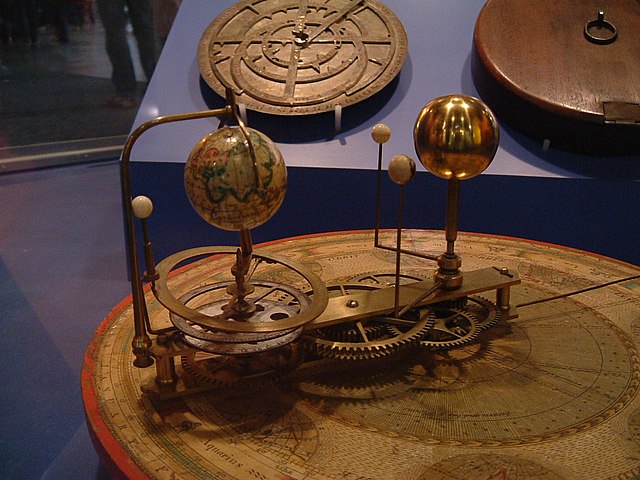The Antikythera mechanism is an Ancient Greek hand-powered orrery, described as the oldest known example of an analogue computer used to predict astronomical positions and eclipses decades in advance. It could also be used to track the four-year cycle of athletic games similar to an Olympiad, the cycle of the ancient Olympic Games.
The Antikythera mechanism (fragment A – front and rear); visible is the largest gear in the mechanism, about 13 cm (5 in) in diameter.
Image: NAMA Machine d'Anticythère 4
Derek J. de Solla Price (1922–1983) with a model of the Antikythera mechanism
Computer-generated front panel of the Freeth model
An orrery is a mechanical model of the Solar System that illustrates or predicts the relative positions and motions of the planets and moons, usually according to the heliocentric model. It may also represent the relative sizes of these bodies; however, since accurate scaling is often not practical due to the actual large ratio differences, a subdued approximation may be used instead. Though the Greeks had working planetaria, the first orrery that was a planetarium of the modern era was produced in 1713, and one was presented to Charles Boyle, 4th Earl of Orrery – hence the name. They are typically driven by a clockwork mechanism with a globe representing the Sun at the centre, and with a planet at the end of each of the arms.
A small orrery showing Earth and the inner planets
Antikythera mechanism, main fragment, c. 205 to 87 BC
Carlo G Croce, reconstruction of Dondi's Astrarium, originally built between 1348 and 1364 in Padua
Astronomical clock (Venus-Mercury side) by Eberhard Baldewein, 1563–1568. Exhibit in the Mathematisch-Physikalischer Salon of Dresden, Germany.







